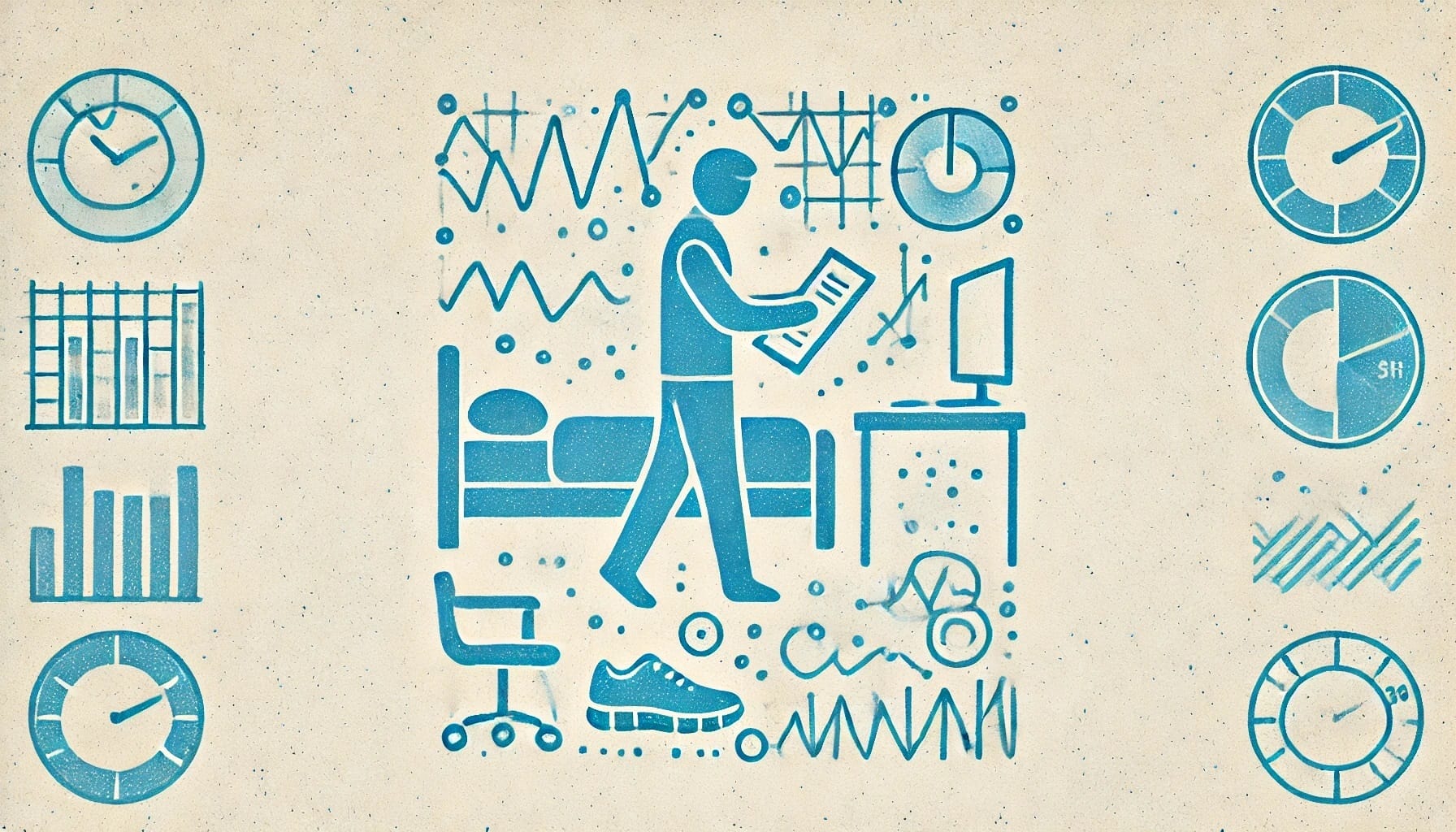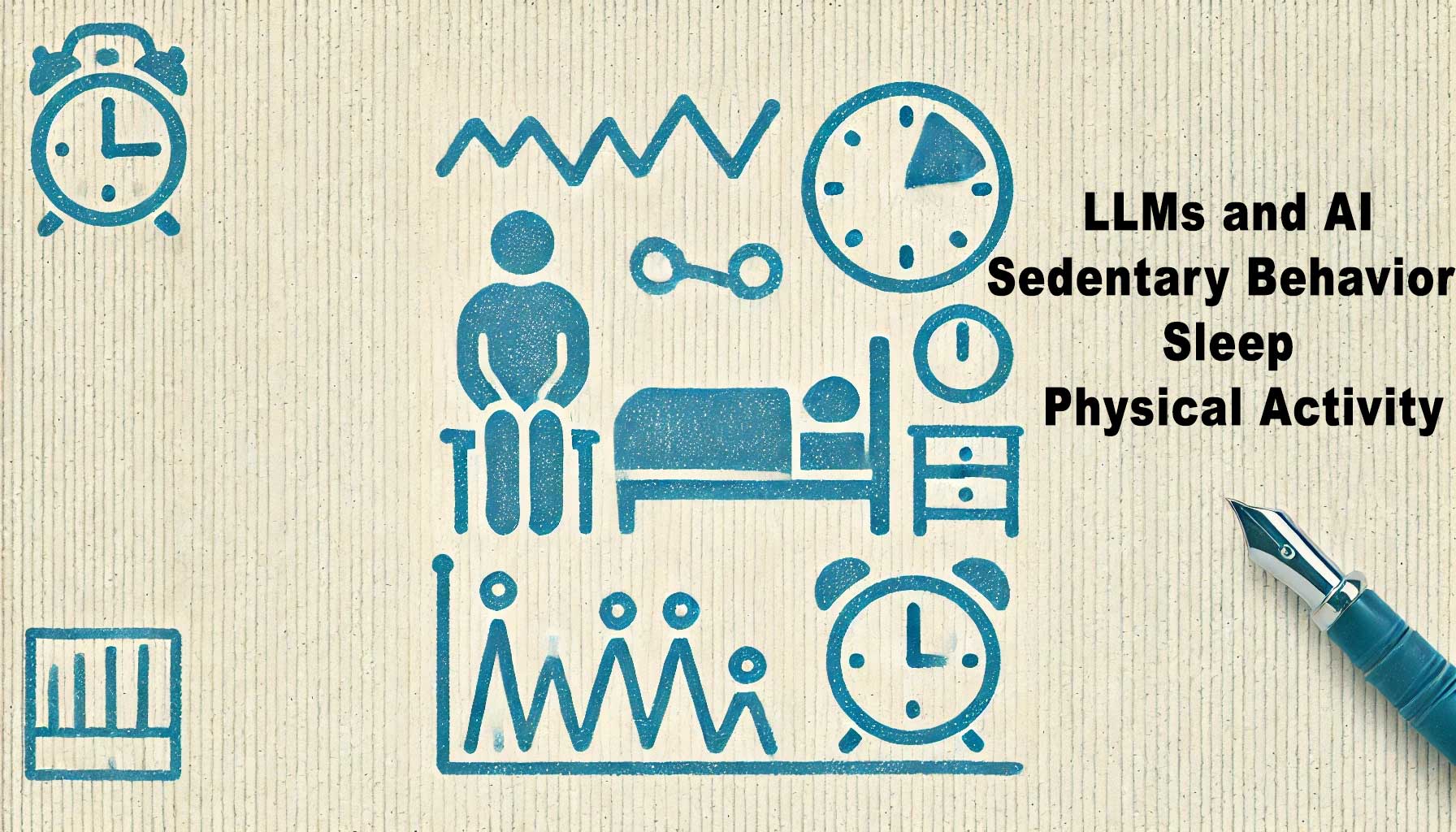Introduction
Robust study designs are crucial for advancing health research. How can modern technology help researchers create more effective and comprehensive study designs?
Large language models (LLMs) and artificial intelligence (AI) offer innovative solutions to these challenges. These advanced tools can integrate diverse data sources, automate data analysis, and uncover patterns that were previously difficult to detect. In this article, we explore how LLMs and AI can enhance study designs across sleep, sedentary behavior, circadian rhythm, and physical activity research.

The Need for Enhanced Study Designs
Challenges in Traditional Study Designs
Traditional study designs often face several challenges:
- Data Integration: Combining data from different sources can be complex and time-consuming.
- Variability: Ensuring consistency and accuracy across diverse datasets is difficult.
- Scalability: Large-scale studies require significant resources and manual effort.
To gain a holistic understanding of health behaviors and outcomes, it is essential to integrate diverse data sources. This comprehensive approach allows researchers to consider multiple factors and their interactions, leading to more accurate and meaningful insights.

The Role of LLMs and AI in Enhancing Study Designs
- Advanced Data Integration: LLMs and AI excel at integrating various data types, such as sensor data, self-reported diaries, environmental factors, biometric data, audio, images, and videos. This ability to combine different data sources provides a comprehensive view of health behaviors and outcomes. For example, integrating data from wearable devices, sleep diaries, weather data, and photos of sleep environments can offer a detailed understanding of sleep and activity patterns. This integrated approach enables researchers to uncover complex relationships and patterns that might be missed when analyzing data in isolation.
- Improving Data Accuracy and Consistency: AI can automate data cleaning and standardization, reducing errors and improving data quality. By standardizing data from different sources, AI ensures consistency in analysis, making it easier to compare and interpret results. For instance, AI can standardize actigraphy data from different wearable devices, ensuring that all data is compatible and comparable. This automation not only improves accuracy but also saves researchers significant time and effort.
- Real-Time Data Collection and Analysis: AI enables continuous monitoring and real-time data collection through wearable devices and other sensors. This real-time analysis provides immediate insights and allows for timely interventions. For example, real-time analysis of physical activity and sleep patterns can help identify issues as they arise, providing opportunities for immediate adjustments and improvements. This capability is particularly valuable for longitudinal studies, where ongoing monitoring is essential.
- Predictive Modeling and Risk Assessment: LLMs can develop predictive models to assess health risks and outcomes based on historical data. By analyzing past behavior and environmental factors, AI can predict future health issues and suggest preventive measures. A case study could show how predictive analytics identify individuals at risk for chronic diseases based on their activity and sleep data. This proactive approach allows for early interventions and personalized health strategies.
- New Study Designs Enabled by AI: The effectiveness and ease of data analysis with AI make previously infeasible study designs possible. AI can handle large, diverse datasets and automate data collection, reducing the cost and workload for researchers. This enables more complex and ambitious study designs that were not feasible before. For example, AI can analyze audio recordings of participants’ sleep diaries, transcribe them, and integrate this data with biometric readings and environmental factors. This allows researchers to use new kinds of data sources, like audio and video, which can be easier to collect and provide richer information.

Practical Applications in Specific Research Areas
- Sleep Research: AI can significantly enhance sleep research by improving the analysis of sleep quality and patterns. By integrating various data sources, such as EEG readings, sleep diaries, and environmental factors, AI can provide a comprehensive view of sleep behavior. For instance, AI can analyze sleep stages, identify disruptions, and recommend personalized interventions to improve sleep quality. By incorporating data on room temperature, light exposure, and other environmental factors, AI can offer tailored advice to enhance the sleep environment.
- Sedentary Behavior Studies: Understanding sedentary behavior patterns and their health impacts is crucial for developing effective interventions. AI can analyze prolonged inactivity periods by integrating actigraphy data from wearable devices, self-reported activity logs, and environmental factors like room temperature and layout. For example, AI can identify times when participants are most sedentary and suggest targeted activities to reduce inactivity. By combining data from various sources, AI can provide a detailed understanding of sedentary behavior across different populations.
- Circadian Rhythm Research: AI can help analyze circadian rhythm disruptions by integrating data from sleep diaries, light exposure sensors, and activity logs. This comprehensive approach allows researchers to understand how different factors influence circadian rhythms and develop strategies to mitigate disruptions. For instance, AI can analyze patterns of light exposure and activity levels to identify shifts in circadian rhythms. This information can be used to recommend changes in daily routines or light exposure to align the circadian rhythm with natural sleep-wake cycles.
- Physical Activity Research: AI can optimize physical activity interventions by personalizing recommendations based on individual data. By analyzing data from wearables, self-reports, and environmental factors, AI can tailor exercise plans to fit personal habits and health conditions. For example, AI can recommend specific exercises based on an individual’s activity patterns, health status, and preferences. This personalized approach can increase adherence to exercise regimens and improve overall health outcomes.

Benefits of Using LLMs and AI in Study Designs
- Enhanced Predictive Accuracy: AI improves the accuracy of health predictions by integrating and analyzing diverse data. By considering multiple variables and their interactions, AI provides more reliable and precise predictions.
- Efficiency and Scalability: AI automates data collection and analysis, making research more efficient and scalable. This reduces the time and resources required for large-scale studies, enabling researchers to conduct more comprehensive and ambitious studies.
- Deeper Insights: LLMs can uncover nuanced insights that traditional methods might miss. By analyzing large datasets and identifying subtle patterns, AI provides a deeper understanding of health behaviors and outcomes.
- Combining Multiple Variables: AI can handle the integration and analysis of numerous variables, which would be challenging manually. This capability allows researchers to consider a wider range of factors in their studies, leading to more comprehensive insights.
- Cost and Workload Reduction: AI reduces the cost and workload for researchers by automating complex tasks. This makes it possible to conduct studies that were previously too expensive or labor-intensive, enabling more innovative research designs.

Future Directions and Implications
Technological Advancements
Future improvements in AI and LLM technology will further enhance study designs in health research. As natural language processing and machine learning algorithms become more sophisticated, AI’s ability to integrate and analyze diverse data sources will improve. This will lead to even more accurate and detailed predictions, allowing researchers to identify trends and patterns with greater precision.
Emerging technologies such as edge computing and the Internet of Things (IoT) will also play a significant role. These technologies will enable real-time data collection and analysis on a much larger scale, providing researchers with timely insights and enabling rapid interventions.
Broader Implications
The potential for AI and LLMs to impact public health and personalized medicine is immense. By providing better research quality and more accurate predictions, these technologies can help develop more effective public health strategies. For instance, predictive models could be used to identify populations at high risk for certain diseases and target interventions more effectively.
In personalized medicine, AI’s ability to analyze individual data and provide tailored recommendations can lead to more personalized and effective treatments. This could significantly improve patient outcomes and reduce healthcare costs by preventing diseases before they become severe.
AI’s ability to handle large and diverse datasets will also support more inclusive research. Traditionally, certain populations have been underrepresented in health research due to the challenges of collecting and analyzing diverse data. AI can overcome these challenges, ensuring that research findings are more representative and applicable to a wider range of individuals.

Conclusion
Large language models and AI offer transformative tools for enhancing study designs in health research. By improving data integration, accuracy, and scalability, AI enables researchers to conduct more comprehensive and effective studies. The ability to handle diverse data sources and automate complex tasks reduces costs and workload, making previously infeasible study designs possible.
As these technologies advance, their applications will continue to expand, opening up new opportunities for innovation in health research. Researchers are encouraged to adopt AI and LLMs in their studies to gain deeper insights and develop more effective interventions. By leveraging these powerful tools, the field of health research can make significant strides toward improving public health and personalized medicine.
Researchers looking to explore the potential of AI and LLMs in their work should consider the following resources and next steps:
- Further Reading: Explore academic papers and articles on the latest advancements in AI and LLM technology.
- Workshops and Training: Participate in workshops and training sessions to gain hands-on experience with these technologies.
- Collaborations: Partner with technology experts to integrate AI into your research projects.
By embracing these technologies, researchers can stay at the forefront of health research, contributing to more effective and innovative study designs.
You Might Also Be Interested
📅 If you want to learn more about Fibion SENS, do not hesitate to book a video call with our expert Dr. Miriam Cabrita.

🔍 Elevate your project with Fibion SENS Motion 3 Devices Test Package for precise activity analysis. Order now for hands-on experience and comprehensive insights.

🔍 You may also discover other valid and reliable products in our portfolio, such as the Fibion Device, Fibion Sleep, Fibion Mimove, Fibion Vitals, Fibion Emfit, and Fibion Circadian, all designed to assist in research measuring physical activity, sedentary behavior, and sleep.
Frequently Asked Questions
How do AI and LLMs enhance health research study designs? +
AI and LLMs improve study designs by integrating diverse data sources, automating data analysis, and uncovering patterns that were previously difficult to detect. This leads to more comprehensive and accurate research findings.
What types of data can LLMs integrate in health research? +
LLMs can integrate various data types, including sensor data, self-reported diaries, environmental factors, biometric data, audio, images, and videos. This comprehensive integration helps in gaining deeper insights into health behaviors and outcomes.
How do AI and LLMs improve data accuracy in health research? +
AI automates data cleaning and standardization, reducing errors and improving data quality. This ensures consistency in analysis and makes it easier to compare and interpret results accurately.
What are the benefits of using AI and LLMs in sleep research? +
In sleep research, AI and LLMs enhance the analysis of sleep quality and patterns by integrating data from EEG readings, sleep diaries, and environmental factors. They can provide personalized interventions and recommendations to improve sleep quality.
How do AI and LLMs benefit physical activity research? +
AI and LLMs optimize physical activity interventions by analyzing data from wearables, self-reports, and environmental factors. They provide personalized exercise plans based on individual patterns, health status, and preferences.















